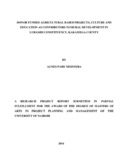| dc.description.abstract | Statistics indicate that a majority of the people living in the developing countries live in rural areas and live below the poverty line. It is shown that these people living in rural areas derive most of their livelihoods form agriculture related activities. In order to improve the livelihoods of these people, it is important to put in place initiatives that can encourage rural development. The problems facing people in rural areas include: poverty due to lack of employment, food insecurity, lack of access to services such as health facilities, electricity, clean water and lack of quality education. In the case of Lurambi constituency it was noted that there were many donor funded agricultural based projects which were involved in the production of crops and livestock . It was also found that there were many schools (both primary and secondary schools). Additionally it was noted that Lurambi constituency had a rich traditional culture which was still being practiced as witnessed in the case of many African traditional communities. The purpose of the study was to describe how various factors contributed to rural development in Lurambi constituency. The factors that were studied were: donor-funded agricultural based projects, participation in the donor funded agriculture based projects, cultural beliefs and practices and level of education and how they contribute to rural development. The research study was guided by the following research questions: to what level do donor funded agricultural based projects contribute to rural development? To what extent does individual participation in rural development contribute to rural development? To what extent do cultural beliefs and practices contribute to rural development? And finally how does the level of education contribute to rural development in the case of Lurambi constituency? The study employed a descriptive survey study. Data relating to the above mentioned variables was collected from the research population which is the people living in Lurambi constituency who have participated in donor funded agricultural based projects. Random sampling was used to select the subjects to be involved in the study sample. Data was collected using questionnaires. Validity of the instruments was ensured by conducting a pilot study on ten percent of the study sample so as to gauge if the instruments were measuring what they were supposed to measure. The reliability of the instruments was measured using test retest method whereby the instrument was administered to a study group during the pilot study at a given time then after a period of two weeks’ time, the instruments was administered again to the same study group . The degree of correlation between the first set of results and the second set of results was assessed using Pearson’s product moment formula to know how reliable the instrument was. Collected data was analyzed descriptively in consultation with experts. Data was subjected to processing and analysis where by the data was processed by classifying, editing and coding and then analyzed using SPSS. The results of the study were presented in frequency distribution tables and interpreted. It was found that there was a positive correlation of 0.895 between participation in donor funded agricultural based projects and income generation and 0.790 in relation to the donor funded agricultural projects and ability to install electricity in homes of participants. These results indicated that there was a significantly positive relationship between participation in donor funded agricultural based projects and rural development. It was also found that there was a positive correlation of 0.701 between level of education and employment as an indicator of rural development. This meant that people who had significantly higher levels of education participated more in developmental activities compared to those with little or no education. It was also found that there was a negative correlation of -0.392 between a large number of children and ability to create employment for other people and a negative correlation of -0.623 between alcohol consumption and the amount of income generated. These results indicated that some cultural practices such as excessive alcohol consumption and large family size had a negative impact on rural development. It was recommended that more donor funded agricultural projects should be introduced and sensitization concerning the projects should be done. | en_US |

